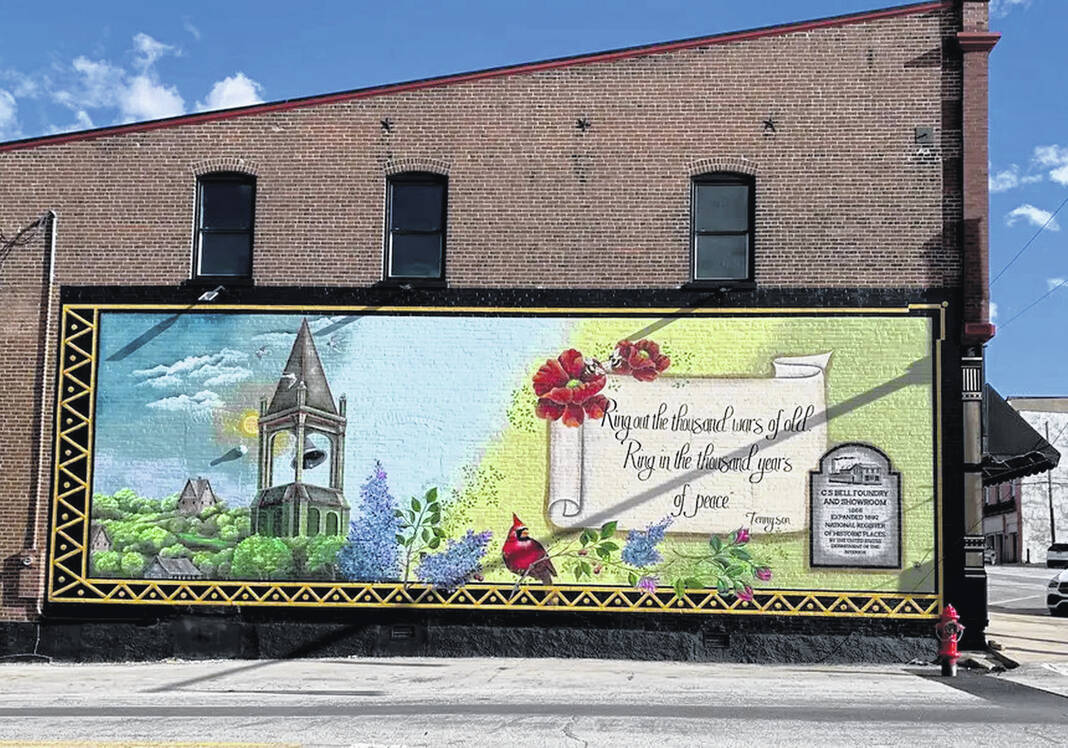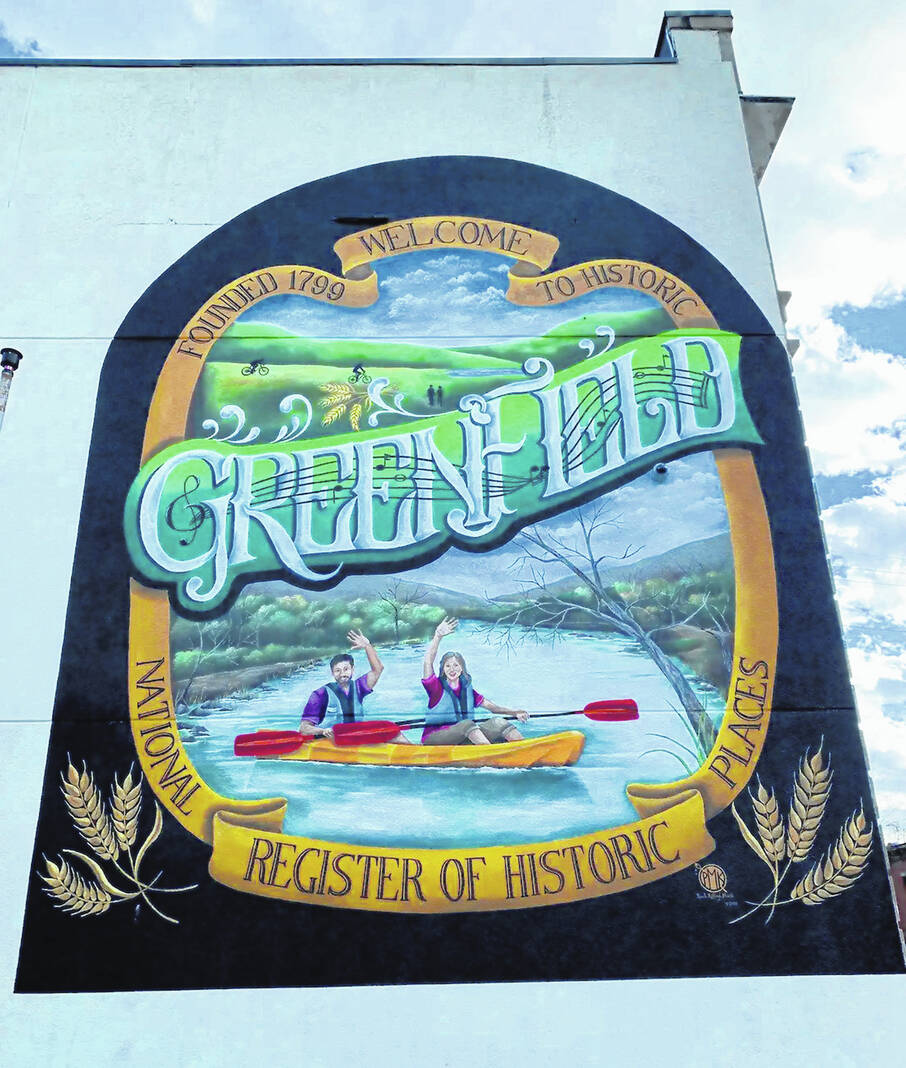
A recently completed mural at the corner of West Main Street and North West Street in Hillsboro celebrates the history of the C.S. Bell Company. Another of Kellough’s C.S. Bell Company themed murals is on West Main Street in Hillsboro, but was not part of the grant project that was funded by the Ohio Arts Council.
Courtesy photo

A mural that is emblazoned on the side of the Merchant’s National Bank building at 117 S. Washington St. in Greenfield, commissioned by the G3 organization and recently completed by area mural artist Pamela Kellough, showcases the inclusion of the downtown area on the National Registry of Historic Places, a distinction that was recently attained.
Courtesy photo
Representatives from the Ohio Arts Council visited Highland County last week in conjunction with the official recognition of murals in Hillsboro and Greenfield, respectively, that were completed last year under the auspices of the organization’s grant funding program and its support of art in rural areas.
The Ohio Arts Council has funded the murals, completed last year, by an area artist at the behest of local nonprofit organizations and pursuant to successful grant applications. The murals in the downtown area of each town are a graphic preservation of the area’s history and heritage, according to the Ohio Arts Council.
The murals are the work of Pamela Kellough, a Chillicothe-based mural artist, who for the past several decades has completed commercial and private commissions in Ohio.
Kellough has worked with various clients and artistic themes, encompassing indoor and outdoor projects all over the state.
“You just kind of start doing it”, Kellough said, describing her evolution as an artist. “It just kind of happens. I just love what I’m being able to do now.”
The mural in Hillsboro, emblazoned with graphic iconography referencing the C.S.Bell Company, is on the side of a building at the corner of West Main and North West streets in Hillsboro that, built in 1892, was once the site of the C.S. Bell Company.
Tim Koehl, who coordinated the mural’s commission, design and execution on behalf of the Highland County Historical Society, said that it was important for the theme of the mural to reference the company’s legacy.
The C.S. Bell Company was founded in 1875, and its designs are still being manufactured from their original patterns in Washington state by Prindle Station Bells, according to owner Sandra Wilson. The company, after which the annual Festival of the Bells has derived its name, is a significant part of local history as the production of its bells, which rung on fleets of U.S. Navy war ships on D-day in World War II, not to mention thousands of schools and churches, were a source of economic revitalization and prosperity for the town. The company’s founder, Charles Singleton Bell, is known as one of Hillsboro’s most renowned and generous historical benefactors, having financed and overseen the construction of the Bells Opera House on South High Street in Hillsboro.
Kellough also completed a separate but similarly themed mural earlier last year in the 100 block of West Main Street in Hillsboro that was not a part of the OAC funded endeavor.
The story of the C.S. Bell Company is one that is personally important to Koehl. “My first job was working at the C.S. Bell Company,” he said.
Koehl said his indoctrination into the business was not without trials and tribulations. At first he said he was out looking for another job when his supervisor confronted him. He said he replied that, “I really liked everybody here, but it was so dirty, dangerous, and hot! I thought that was the end of my career. In fact, the opposite happened.”
He said his supervisor, Jack, who would later become a business partner, “laughed and told me to give it a shot. He assured me that there was opportunity to be had.”
Rather than being the end of his involvement with the company, it was just the beginning. Years later, Koehl presided over the planning of the mural commemorating it.
The Ohio Arts Council described the second Hillsboro mural by saying it showcased the power of storytelling and its ability to bring a community’s history to life.
The first mural, the OAC said, recognized the historical contributions of the C.S. Bell Company.
The Greenfield mural was one that might not have happened, if not for a timely intervention from Koehl, explained one of the people that applied for the OAC grant that would eventually bring to fruition a long-stalled project that had been a dream of a cadre of individuals dedicated to aesthetic community improvement.
Merleen Van Dyke, board member and former president of G3, a Greenfield nonprofit organization, said that the group wanted to enhance Greenfield with a mural, but that funding was an issue.
“Pam Kellough had done a mural in Bainbridge and one in Frankfort that I was aware of,” Van Dyke said. “(I) mentioned it to the board at the time,” and they concurred with an interest in commissioning a mural for Greenfield from Kellough.
“She’s great. We invited Pam to come to one of our board meetings,” Van Dyke said. “This was early stages, just throwing it out there. Wouldn’t it be great to get one of her murals here in Greenfield?” she said she thought. “So Pam came to a meeting, brought her portfolio, we talked.”
Financial constraints curtailed the discussion for a while, and the project was put on the back burner.
But a phone call from Koehl unexpectedly turned out to be a catalyst that would spurn the project. He said the Ohio Arts Council had grant money and was trying to get it to rural communities.
Van Dyke said they were approved for funding for the mural from the OAC, holding a community fundraiser to raise the difference for costs not covered in the grant.
Once they knew they could actually make it happen, they again initiated plans with Kellough to complete the mural.
Then there was the process of selecting a wall on which the mural could be emblazoned. Eventually they decided on a wall at Merchants National Bank.
The Ohio Arts Council described the Greenfield mural as having depicted the theme of, welcome to historic Greenfield the way it would have been perceived by the area’s first settlers.
Rather than being isolated works of art, the OAC said these and other similar murals are inclusive of a greater effort to artistically enhance rural communities and imbue them with graphic representations of local heritage and history.
Brianna Dance, OAC organizational programs coordinator, said that, “The murals in Hillsboro and Greenfield are examples of these wonderful assets within small communities, which are devoted community members, a strong sense of regional pride and history, and a commitment to local artists.”
Dance said, “The arts in rural communities help to strengthen the areas’s sense of place and often reflect its history, which promotes a deeper understanding and appreciation of the region.” She said the initiative shown by Koehl, Van Dyke, Evans and others is indicative of their investment in the community.
“The local leaders and organizations making the arts happen in small towns recognize its impact in beautifying community, encouraging tourism, and highlighting the talent of their resident artists,” Dance said.
Justin Nigro, OAC Operations and Public Affairs Director, emphasized that being inclusive of rural communities is a priority of the organization. He said that beyond providing public funding for the arts, the OAC prides itself on having a presence statewide through its staff outreach.”
“Visiting communities of all sizes is a critical part of making sure that folks know that public funding is available and that out staff is accessible and ready to turn their ideas into grant applications,” he said. “Public art is an essential part of inspiring communities with a sense of local pride and identity, while making nearby areas more inviting and attractive.
“Artist Pamela Kellough’s beautiful murals achieve all this and much more, by providing educational value and a historical perspective of Hillsboro and Greenfield. The murals will bring greater awareness of Highland County’s cultural heritage and history to residents and visitors for years to come.”
The Ohio Arts Council, according to its website, was created in 1965 to encourage the development of the arts and assist in the preservation of Ohio’s cultural heritage.
Juliane Cartaino is a stringer for The Times-Gazette.

